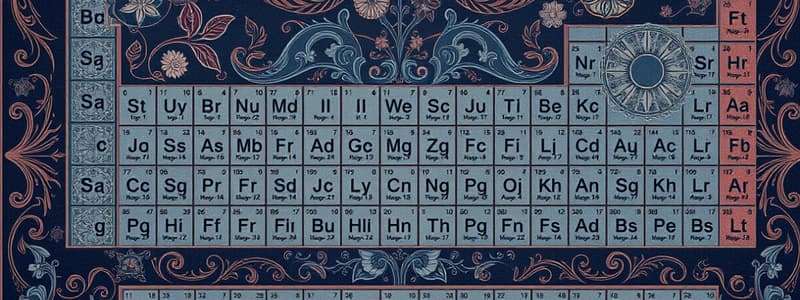Podcast
Questions and Answers
What are Groups/Families in the periodic table?
What are Groups/Families in the periodic table?
- Both B and C (correct)
- Elements with similar properties
- Horizontal rows
- Vertical columns
What are Periods in the periodic table?
What are Periods in the periodic table?
- Both B and C
- Vertical columns
- Horizontal rows (correct)
- Elements with similar properties
Metals make up the majority of the periodic table.
Metals make up the majority of the periodic table.
True (A)
Which of the following is a property of metals?
Which of the following is a property of metals?
Which of the following describes nonmetals?
Which of the following describes nonmetals?
What are Semi-Metals (Metalloids)?
What are Semi-Metals (Metalloids)?
What defines Transition Metals?
What defines Transition Metals?
What are Noble Gases known for?
What are Noble Gases known for?
What are Alkali Metals?
What are Alkali Metals?
What are Halogens?
What are Halogens?
Most elements exist as ______ in nature.
Most elements exist as ______ in nature.
Define Diatomic Elements.
Define Diatomic Elements.
What does the 's, p, d, and f blocks' refer to?
What does the 's, p, d, and f blocks' refer to?
What is meant by Atomic Radius?
What is meant by Atomic Radius?
Why does the Atomic Radius increase as you move down a group?
Why does the Atomic Radius increase as you move down a group?
What does Ionization Energy refer to?
What does Ionization Energy refer to?
Why does the Ionization Energy decrease as you go down a group?
Why does the Ionization Energy decrease as you go down a group?
Why does the Ionization Energy increase as you move across a period?
Why does the Ionization Energy increase as you move across a period?
Flashcards are hidden until you start studying
Study Notes
Organization of the Periodic Table
- The periodic table is organized into groups (vertical columns) labeled #1-18, where elements in the same group share similar chemical properties due to identical valence electron counts.
- Periods (horizontal rows) are numbered #1-7, indicating the highest principal energy shell occupied by elements.
Types of Elements
- Metals constitute the majority of the periodic table, situated to the left of the 'staircase'.
- Nonmetals are fewer in number and exhibit a wider variation in properties compared to metals.
- Semi-metals, or metalloids, possess characteristics of both metals and nonmetals.
Properties of Metals
- Most metals are solid (except for Mercury), malleable, ductile, hard, lustrous, and excellent conductors of heat and electricity.
- Metals tend to lose electrons, forming positive ions.
- Metallic properties increase moving down a group and decrease across a period, with Francium being the most metallic.
Properties of Nonmetals
- Most nonmetals are gases in their natural form (except Bromine, a liquid), exhibit brittleness, and are nonmalleable and nondductile.
- Nonmetals lack luster, are poor conductors of heat and electricity, and gain electrons to form negative ions.
Transition Metals
- Transition metals, found in Groups 3-12, are known for forming colorful ions.
- Properties include high melting points (except Mercury), the capacity to form colored ions, and a variable number of valence electrons removed from p and d sublevels. They are generally less reactive than Groups 1 and 2 metals.
Rare Earth Metals
- Lanthanide Series encompasses elements with atomic numbers 58-71 and is commonly referred to as rare earth metals.
- Actinide Series includes elements with atomic numbers 90-103, most of which are radioactive and synthetically produced.
Noble Gases
- Group 18 contains noble gases that are inert due to having a full valence shell.
- Helium, despite having only 2 valence electrons, is classified as a noble gas.
Alkali and Alkaline Earth Metals
- Alkali Metals (Group 1) are the most reactive metals, with Francium as the most reactive.
- Alkaline Earth Metals (Group 2) are the second most reactive set of metals.
Halogens
- Halogens are found in Group 17 and are recognized as the most reactive nonmetals.
Physical States of Elements
- Most elements naturally exist as solids; notable exceptions include Mercury (liquid) and gases such as Hydrogen, Nitrogen, Oxygen, Fluorine, Chlorine, and all noble gases.
Diatomic Elements
- Certain elements exist as diatomic molecules in nature, including Bromine, Iodine, Nitrogen, Chlorine, Hydrogen, Oxygen, and Fluorine.
Electron Configuration and Block Designation
- The periodic table is divided into blocks: S block (Groups 1&2), P block (Groups 13-18), D block (Groups 3-12), and F block (Lanthanide & Actinide series).
Allotropes
- Different structural forms of nonmetals that coexist in the same physical state due to variations in atomic bonding and arrangement, leading to distinct physical and chemical properties.
Atomic Trends
- Metallic character increases down a group and decreases across a period.
- Atomic radius increases down a group as additional energy levels are added, while it decreases across a period due to increased nuclear charge attracting electrons more closely.
Ionization Energy
- Ionization energy (IE) refers to the energy required to remove an electron from an atom.
- IE decreases down a group as more energy levels lead to easier electron removal and increases across a period due to greater nuclear attraction as protons are added.
Electronegativity
- Electronegativity is a measure of an atom's ability to attract and bond with electrons. It generally increases across a period and decreases down a group.
Studying That Suits You
Use AI to generate personalized quizzes and flashcards to suit your learning preferences.




